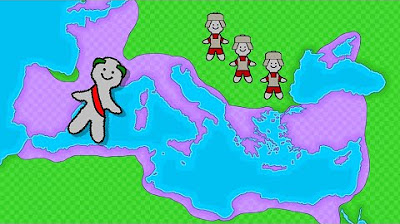ROMANS in Spain
Summary
TLDRThe Roman conquest of the Iberian Peninsula, lasting from 218 BC to 19 AD, aimed to control the western Mediterranean, exploit resources like gold, silver, and oil, and expand Rome's reach to Europe’s westernmost point. The video traces key events including Hannibal's campaigns, the resistance of local tribes like Viriato and the Numantians, and the eventual Roman victory. Roman rule transformed the region through Latin language, law, Christianity, and urban development. Key Roman figures like Trajan, Hadrian, and Seneca were born in Hispania, which became one of the most Romanized provinces.
Takeaways
- 🏛️ The Roman conquest of the Iberian Peninsula lasted from 218 BC to 19 AD and gave Spain its name, 'Hispania.'
- ⚔️ Rome aimed to control the western Mediterranean, exploit the region's wealth, and conquer Europe up to Cape Finisterre.
- 🛡️ The Second Punic War saw Roman conflict with Carthage, with leaders like Hannibal, who famously crossed the Alps with elephants.
- 🚩 Key Roman victories, such as the Battle of Ilipa, led to Carthage's expulsion from the Iberian Peninsula and Rome's consolidation of power.
- 🦸 The Romans faced strong resistance from Iberian tribes, like the warlords DeBell and Mondo Neo, as well as guerrilla leader Viriato.
- 🔪 Viriato resisted Roman forces for seven years through guerrilla warfare but was ultimately betrayed and assassinated.
- 🏙️ Roman rule introduced key elements of Romanization, including Latin, which influenced 70% of the modern Spanish language.
- ⛪ Christianity replaced the polytheistic Roman religion, becoming the official religion of the Roman Empire by the 4th century.
- 🛣️ Rome built an extensive network of roads and cities in Hispania, including Cadiz, Córdoba, and Segovia, many still notable for their architecture.
- 🏺 Significant Roman figures like emperors Trajan, Hadrian, and philosopher Seneca were born in Hispania, highlighting its importance to Rome.
Q & A
What were the main reasons for Rome's conquest of the Iberian Peninsula?
-Rome conquered the Iberian Peninsula for three main reasons: control of the western Mediterranean, exploiting the wealth from mines (gold, silver, wine, and oil), and a geographical goal of expanding its empire to the westernmost part of Europe, reaching Cape Finisterre.
When did the Roman conquest of the Iberian Peninsula begin, and how long did it last?
-The Roman conquest of the Iberian Peninsula began in 218 BC and lasted until 19 AD, taking approximately two centuries to complete.
Who initiated the Roman conquest of the Iberian Peninsula, and what was the significance of the landing at Emporion?
-The Roman conquest was initiated by Publio Cornelio Scipio, who landed at Emporion (modern-day Empúries in Girona) during the Second Punic War. This landing marked the beginning of the Roman effort to take control from the Carthaginians.
What role did Hannibal play in the conflict between Rome and Carthage in the Iberian Peninsula?
-Hannibal, the Carthaginian general, famously crossed the Pyrenees and the Alps with his army, which included elephants, to attack Rome. However, after his defeat at the Battle of Zama in Africa, Carthage lost control of the Iberian Peninsula to Rome.
Who was Viriatus, and how did he resist Roman forces?
-Viriatus was a Portuguese warlord who used guerrilla warfare tactics to resist Roman forces for seven years. Despite signing a peace treaty with Rome, he was eventually assassinated by three of his lieutenants, who were later executed by the Romans for treachery.
What was the significance of the city of Numancia in the Roman conquest of Hispania?
-Numancia, a Celtiberian city, was besieged by the Romans for 15 months. Despite overwhelming Roman forces, the inhabitants of Numancia chose to commit suicide rather than surrender and become Roman slaves, symbolizing fierce resistance to Roman rule.
How did the Roman general Quintus Sertorius contribute to the Romanization of the Iberian Peninsula?
-Quintus Sertorius fought against Pompey the Great in the Sertorian Wars (82–72 BC), during which Iberian tribes were involved on both sides. These conflicts helped to integrate the local tribes into the Roman Empire and advanced the Romanization process.
How did the Roman Empire shape the cultural and political landscape of Hispania?
-Romanization in Hispania was based on four principles: Latin language replaced indigenous languages, polytheism was replaced by Christianity, Roman law introduced legal concepts and state organization, and urban infrastructure like roads and cities facilitated governance and trade.
What were some of the major Roman engineering feats in the Iberian Peninsula?
-Notable Roman engineering accomplishments in Hispania include the walls of Lugo, the aqueduct of Segovia, the Alcántara bridge, and the amphitheater at Mérida. These structures highlighted the advanced engineering and architectural skills of the Romans.
Which notable figures from Roman history were born in Hispania?
-Several important Roman figures were born in Hispania, including emperors Trajan, Hadrian, and Theodosius, the philosopher Seneca, the poet Martial, and the orator Quintilian.
Outlines

Cette section est réservée aux utilisateurs payants. Améliorez votre compte pour accéder à cette section.
Améliorer maintenantMindmap

Cette section est réservée aux utilisateurs payants. Améliorez votre compte pour accéder à cette section.
Améliorer maintenantKeywords

Cette section est réservée aux utilisateurs payants. Améliorez votre compte pour accéder à cette section.
Améliorer maintenantHighlights

Cette section est réservée aux utilisateurs payants. Améliorez votre compte pour accéder à cette section.
Améliorer maintenantTranscripts

Cette section est réservée aux utilisateurs payants. Améliorez votre compte pour accéder à cette section.
Améliorer maintenant5.0 / 5 (0 votes)






